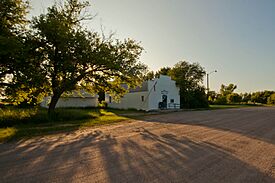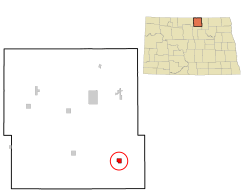Mylo, North Dakota facts for kids
Quick facts for kids
Mylo, North Dakota
|
|
|---|---|

Post office in Mylo
|
|

Location of Mylo, North Dakota
|
|
| Country | United States |
| State | North Dakota |
| County | Rolette |
| Founded | 1905 |
| Area | |
| • Total | 0.86 sq mi (2.23 km2) |
| • Land | 0.86 sq mi (2.23 km2) |
| • Water | 0.00 sq mi (0.00 km2) |
| Elevation | 1,654 ft (504 m) |
| Population
(2020)
|
|
| • Total | 21 |
| • Estimate
(2023)
|
18 |
| • Density | 24.36/sq mi (9.41/km2) |
| Time zone | UTC–6 (Central (CST)) |
| • Summer (DST) | UTC–5 (CDT) |
| ZIP Code |
58353
|
| Area code(s) | 701 |
| FIPS code | 38-55220 |
| GNIS feature ID | 1036174 |
Mylo is a small city in Rolette County, North Dakota, in the United States. In 2020, only 21 people lived there. Today, Mylo has a United States Post Office, but no other businesses or services.
Contents
History of Mylo
How Mylo Began
Mylo started in June 1905 when land lots were sold. Later that year, in November, the Minneapolis, St. Paul and Sault Ste. Marie railroad, also known as the "Soo Line," reached Mylo. On November 18, 1905, railroad crews met just west of Mylo, finishing this important farming branch of the Soo Line.
A Post Office opened in Mylo in 1905. It served the town until 2011. For many years, it also delivered mail to the nearby city of Perth, North Dakota. Mylo officially became a village in 1907.
Early Decisions by the City Council
The Mylo City Council made many interesting decisions over the years:
- On April 8, 1908, they decided to build sidewalks. These sidewalks had to be made of thick planks or cement and be eight feet wide.
- In September 1910, the council bought five street lamps. Ole Peterson was paid $10 to light them for two years!
- In January 1912, Wm. Hazlett was paid one dollar for feeding prisoners.
- On October 10, 1918, a special meeting was held. They decided to stop all public gatherings to help prevent the spread of the influenza (flu).
- In April 1921, they voted to put up posts where people could tie their horses.
- In September 1927, the town voted to get electricity. This allowed Otter Tail Power Co. to bring electric lights, heat, and power to Mylo. All 45 votes were in favor!
- In January 1937, after new laws about selling alcohol, the council decided they needed more police to keep order in the village.
- In 1954, Mylo made a deal with Northwest Bell Telephone Co. This allowed poles and wires to be set up so residents could finally have telephones in their homes. Some businesses had phones before this.
Where Did the Name Mylo Come From?
No one is completely sure how Mylo got its name. Some people think it was named after Melvin Small, who owned the land where the town was built. Others believe it was named after Father Malo, who was the first priest in Rolette County. Another idea is that it was named after the Soo Line railroad agent who helped choose the town's location.
Mylo's Population Over Time
Mylo was at its busiest in 1920, with 140 people living there. By 2010, the population was 20, and there were no businesses left. The school in Mylo closed in 1973, and the last business shut down in 1986.
Geography
Mylo is a small city. According to the United States Census Bureau, the city covers about 0.86 square miles (2.23 square kilometers) of land. There is no water area within the city limits.
Population Information
| Historical population | |||
|---|---|---|---|
| Census | Pop. | %± | |
| 1910 | 98 | — | |
| 1920 | 140 | 42.9% | |
| 1930 | 134 | −4.3% | |
| 1940 | 89 | −33.6% | |
| 1950 | 110 | 23.6% | |
| 1960 | 103 | −6.4% | |
| 1970 | 51 | −50.5% | |
| 1980 | 31 | −39.2% | |
| 1990 | 20 | −35.5% | |
| 2000 | 19 | −5.0% | |
| 2010 | 20 | 5.3% | |
| 2020 | 21 | 5.0% | |
| 2023 (est.) | 18 | −10.0% | |
| U.S. Decennial Census 2020 Census |
|||
Mylo in 2010
In 2010, there were 20 people living in Mylo, spread across 9 homes. Four of these homes were families.
- About 22% of homes had children under 18.
- About 44% were married couples.
- About 44% were single people living alone, and some of these were people aged 65 or older.
- The average home had 2.22 people, and the average family had 3.50 people.
Most people in Mylo were White (95%). A small number (5%) were Native American. The average age of people in Mylo was 45.5 years old.
- 30% of residents were under 18.
- 20% were between 25 and 44.
- 40% were between 45 and 64.
- 10% were 65 or older.
The number of males and females in Mylo was about equal.
Education
Mylo had a school that was built in 1910. It taught students from kindergarten through eighth grade. Mylo never had its own high school. After eighth grade, students usually went to high school in nearby Bisbee or Rolette, North Dakota. The Mylo school closed in the spring of 1973. After that, Mylo became part of the Rolette School District. Today, students from Mylo attend the Rolette Public School.
See also
 In Spanish: Mylo (Dakota del Norte) para niños
In Spanish: Mylo (Dakota del Norte) para niños

